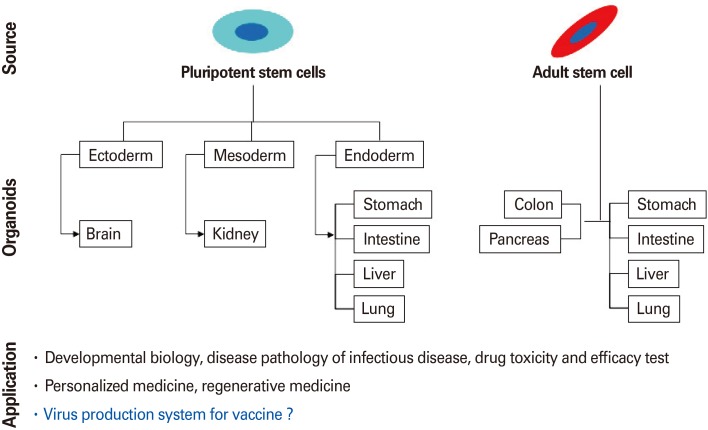Clin Exp Vaccine Res.
2018 Jul;7(2):145-148. 10.7774/cevr.2018.7.2.145.
Organoid as a culture system for viral vaccine strains
- Affiliations
-
- 1Interpark Bio-convergence Center, Seoul, Korea. Sanghwan.Seo@ivi.int
- KMID: 2418093
- DOI: http://doi.org/10.7774/cevr.2018.7.2.145
Abstract
- Organoid is an in vitro multicellular form mimicking in vivo organ. Its similarity to human organ including cellular organization, molecular expression patterns, as well as genetic signatures enables to study the characteristics of infectious agents and host-pathogen interaction. For the features of organoid, this system also can be potentially used to cultivate currently uncultivable viruses of vaccine candidates. This paper will briefly describe problems in the current culture system for virus production and the possibility of organoid as culture system for viral vaccine and their current limitations that should be solved to meet the goal.
MeSH Terms
Figure
Reference
-
1. Ciarlet M, Estes MK, Barone C, Ramig RF, Conner ME. Analysis of host range restriction determinants in the rabbit model: comparison of homologous and heterologous rotavirus infections. J Virol. 1998; 72:2341–2351. PMID: 9499095.
Article2. Ward LA, Rosen BI, Yuan L, Saif LJ. Pathogenesis of an attenuated and a virulent strain of group A human rotavirus in neonatal gnotobiotic pigs. J Gen Virol. 1996; 77(Pt 7):1431–1441. PMID: 8757984.
Article3. Hoshino Y, Saif LJ, Kang SY, Sereno MM, Chen WK, Kapikian AZ. Identification of group A rotavirus genes associated with virulence of a porcine rotavirus and host range restriction of a human rotavirus in the gnotobiotic piglet model. Virology. 1995; 209:274–280. PMID: 7747480.
Article4. Kitamoto N, Ramig RF, Matson DO, Estes MK. Comparative growth of different rotavirus strains in differentiated cells (MA104, HepG2, and CaCo-2). Virology. 1991; 184:729–737. PMID: 1653495.
Article5. Superti F, Tinari A, Baldassarri L, Donelli G. HT-29 cells: a new substrate for rotavirus growth. Arch Virol. 1991; 116:159–173. PMID: 1848062.
Article6. Hu W, Zhang H, Han Q, et al. A Vero-cell-adapted vaccine donor strain of influenza A virus generated by serial passages. Vaccine. 2015; 33:374–381. PMID: 25448099.
Article7. Blaney JE Jr, Manipon GG, Firestone CY, et al. Mutations which enhance the replication of dengue virus type 4 and an antigenic chimeric dengue virus type 2/4 vaccine candidate in Vero cells. Vaccine. 2003; 21:4317–4327. PMID: 14505914.
Article8. Zeiger RS. Current issues with influenza vaccination in egg allergy. J Allergy Clin Immunol. 2002; 110:834–840. PMID: 12464947.
Article9. World Health Organization. Japanese encephalitis [Internet]. Geneva: World Health Organization;2014. cited 2018 Jul 1. Available from: http://www.who.int/biologicals/vaccines/japanese_encephalitis/en/.10. Ramani S, Crawford SE, Blutt SE, Estes MK. Human organoid cultures: transformative new tools for human virus studies. Curr Opin Virol. 2018; 29:79–86. PMID: 29656244.
Article11. Dutta D, Heo I, Clevers H. Disease modeling in stem cell-derived 3D organoid systems. Trends Mol Med. 2017; 23:393–410. PMID: 28341301.
Article12. Sato T, Vries RG, Snippert HJ, et al. Single Lgr5 stem cells build crypt-villus structures in vitro without a mesenchymal niche. Nature. 2009; 459:262–265. PMID: 19329995.
Article13. Spence JR, Mayhew CN, Rankin SA, et al. Directed differentiation of human pluripotent stem cells into intestinal tissue in vitro. Nature. 2011; 470:105–109. PMID: 21151107.
Article14. Finkbeiner SR, Zeng XL, Utama B, Atmar RL, Shroyer NF, Estes MK. Stem cell-derived human intestinal organoids as an infection model for rotaviruses. MBio. 2012; 3:e00159–e00112. PMID: 22761392.
Article15. Ettayebi K, Crawford SE, Murakami K, et al. Replication of human noroviruses in stem cell-derived human enteroids. Science. 2016; 353:1387–1393. PMID: 27562956.
Article16. Garcez PP, Loiola EC, Madeiro da, et al. Zika virus impairs growth in human neurospheres and brain organoids. Science. 2016; 352:816–818. PMID: 27064148.
Article17. Cugola FR, Fernandes IR, Russo FB, et al. The Brazilian Zika virus strain causes birth defects in experimental models. Nature. 2016; 534:267–271. PMID: 27279226.
Article
- Full Text Links
- Actions
-
Cited
- CITED
-
- Close
- Share
- Similar articles
-
- Suspension culture of Vero cells for the production of adenovirus type 5
- Organoids as a New In Vitro Model of Human Norovirus Infection
- Engineering the Extracellular Matrix for Organoid Culture
- Reverse genetic platform for inactivated and live-attenuated influenza vaccine
- Molecular Identification of the Vaccine Strain from the Inactivated Rabies Vaccine


